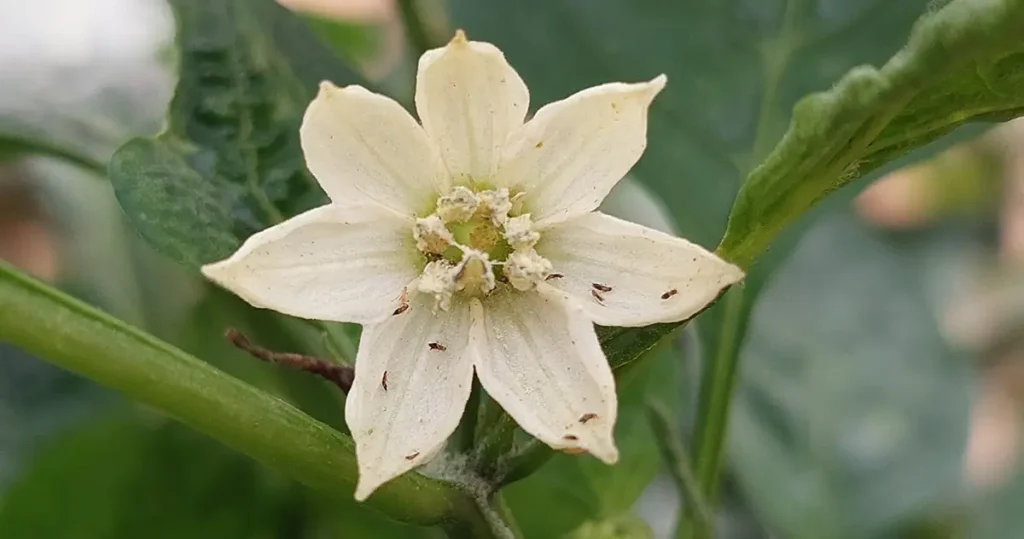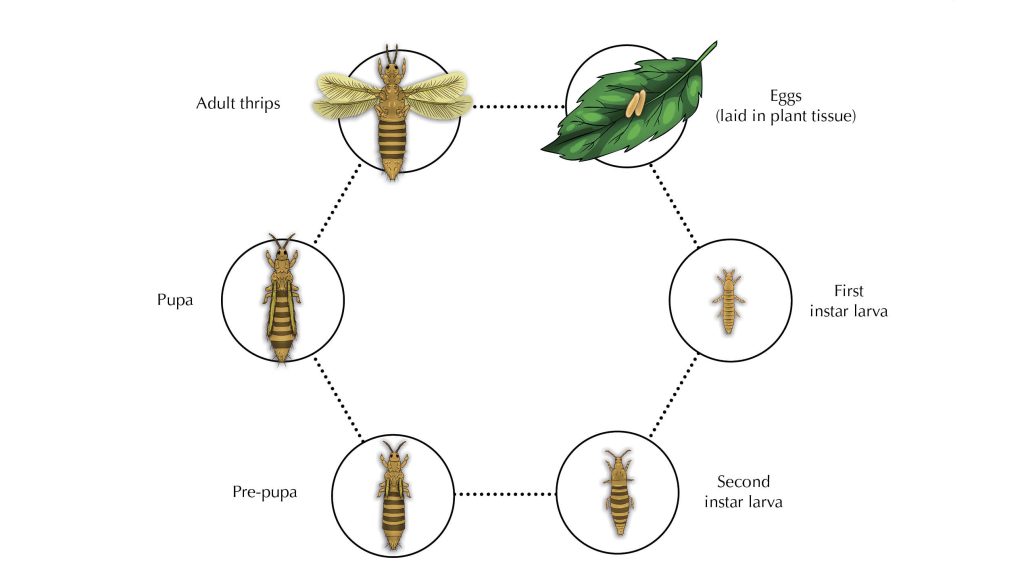Thrips are one of the important sucking pests that significantly impact chilli crops. Scirtothrips dorsalis infest the crop from their seedling stage to the reproductive stage, causing extensive damage by sucking the sap from leaves, shoots, buds and fruits. This can lead to severe yield losses and even crop failure if not managed effectively. According to a study, 40 to 80 per cent of the damage to chilli crop in Andhra Pradesh and Telangana is due to thrips.
But how can we know if it is thrips? What does the damage look like? What methods to adopt to get rid of them?
Symptoms of Chilli Thrips Infestation
Thrips are not specified to single plant parts, they feed on flowers, leaves and also on the fruits.
On Leaves:

Thrips suck sap from leaves, causing leaves to curl upwards and give a crinkling appearance. This is not the only symptom on leaves, along with sucking sap from leaves, thrips lacerate the leaf surface, leading to a silvery or bronze discoloration. The leaves of the infested plants often have elongated petioles. On the undersides of infested leaves, you can see reddish-brown discoloration.
On Flowers:

Thrips won’t just damage leaves but also attack flowers. Affected flower buds become brittle and eventually drop. Due to scraping by thrips, you can see brown streaks on the petals. Severe infestation leads to drying and withering of flowers.
On Fruits:

Thrips feed on developing fruits, leaving small, light brown scars on the surface. Early-stage infestation results in stunted plant growth and ceases flower production and fruit set.
Understanding Why These Symptoms Occur
Thrips cause damage majorly through their feeding habits. Both adult and nymph stages feed by sucking the plant sap, which lead to tissue damage and disruption of nutrient flow. This feeding results in the characteristic symptoms of leaf curl, silvery or bronze appearance and crinkling of leaves.
The damage disrupts normal plant growth, reduces photosynthetic ability and leads to secondary infections, ultimately weakening and potentially killing the plant.
Understanding the Life Cycle of Chilli Thrips

The lifecycle of chilli thrips consists of the egg, larva, pre-pupa, pupa and adult stages. Females lay eggs on the leaf surface, and on hatching, larvae begin feeding on the plant. Larvae undergo several molting stages before becoming pupae, which then transform into adults. This cycle is rapid, especially in favorable conditions, leading to quick population build-up.
Identification of Chilli Thrips
Nymphs: Small, yellowish and found mainly on the undersides of leaves.
Adults: Tiny insects with fringed wings, also found on the undersides of leaves and on flowers.
Favourable Conditions for the Spread of Chilli Thrips
Thrips can survive in warm, dry weather. They spread quickly in such conditions, making it essential to monitor and manage them, especially during hot, dry periods.
Effective Strategies for Controlling Chilli Thrips
Preventing Chilli Thrips Through Cultural Methods
Grow Resistant Varieties: Plant varieties that are less susceptible to thrips.
Intercropping: Plant maize or sorghum alongside chilli to provide shade, which helps reduce thrips populations.
Avoid Certain Crop Rotations and Mixed Cropping: It is also advisable to avoid planting chili after sorghum cultivation, as this sequence can worsen and increase susceptibility to thrips.
Avoid mixed cropping chillies with onions to mitigate thrips infestation.
Water Management: Sprinkling water on seedlings can help reduce thrips numbers.
Remove Infested Plants: Remove and destroy heavily infested plants to prevent the spread.
Placing Sticky Traps: To monitor thrips in the chilli field and to mass trap the thrips, place blue and yellow sticky traps.
Trap Crops to the rescue! Planting marigold and sunflower as trap crops helps reduce thrips damage.
Biological Ways to Reduce Chilli Thrips
Natural Predators: Increasing the population of natural predators like predatory mites to control thrips populations.
Neem Oil: Spray neem oil on plants to limit thrips damage.
Chemical Solutions for Chilli Thrips
Chemicals containing Imidacloprid 17.8% SL (3 ml per 10 litres of water), Spinosad 45% SC (3.2 ml per 10 litres of water), Fipronil 5% SC (1.5 ml per litre of water), Thiamethoxam 25% WG (0.5 gm per litre of water), Spinetoram 11.7% SC (0.9 ml per litre of water), Emamectin Benzoate 5% SG (0.4 gm per litre of water), Diafenthiuron 47% + Bifenthrin 9.4% SC (1.25 – 1.5 ml per litre of water), Acetamiprid 20% SP (0.1 – 0.2 gm per litre of water), Cyantraniliprole 10.26% OD (1.7 to 2.0 ml per litre of water), Broflanilide 300 G/L SC (0.2 ml per litre of water), Fluxametamide 10% EC (1 ml per litre of water or 160 ml per acre) or Pyridaben 20% w/w WP (1 gm per litre of water) are effective in controlling thrips in chilli field.
Regular monitoring and early intervention is important which plays a major role in keeping thrips populations under control and ensuring a healthy, productive chilli crop.